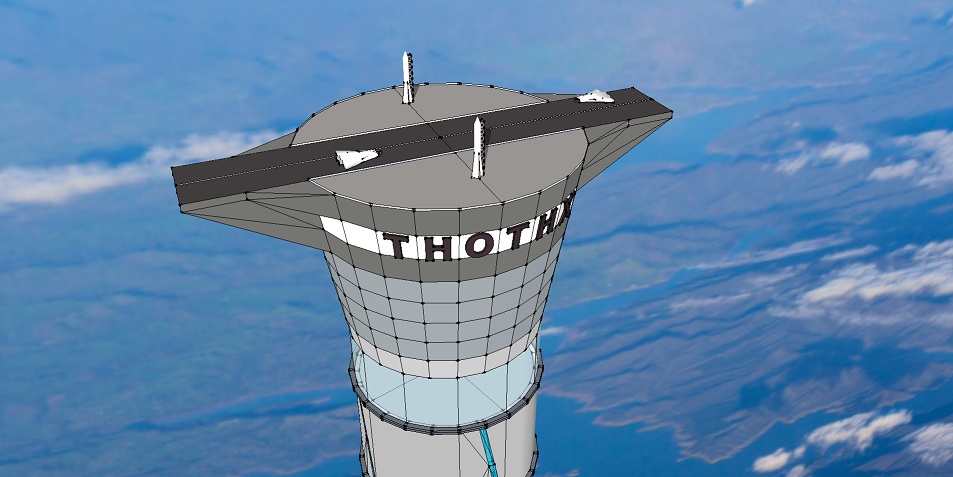
As futuristic concepts go, few things can compete with the sheer power and promise of the Space Elevator! Originally suggested by Russian engineer Konstantin Tsiolkovsky in 1895, the idea of creating a massive structure that could reach into geostationary orbit (GSO) has become a popular concept amongst engineers and futurists all around the world.
And in recent decades, a number of advances have been made that have led many scientists to reconsider the feasibility of this idea. Namely, Canadian space firm, Thoth Technology, recently received a patent for an inflatable Space Elevator that utilizes reinforced, pressurized sections to create a tower that would reach into Low Earth Orbit (LEO).
In addition to being science fiction gold, a Space Elevator would offer numerous benefits when it comes to space travel. At present, one of the greatest problems with space-based research and exploration is the sheer cost associated with sending satellites, crews, and spacecraft into orbit. In fact, sending a single payload 100 km up currently costs as much as $25,000 per kg ($11,000 per lb). In contrast, a Space Elevator could reduce that to an estimated $220 per kg ($100 per lb).

To engineers and speculative thinkers, a Space Elevator is intrinsic to humanity's future in space. Credit: IO9.com
Being able to send payloads into space at 1/100th their current cost would not only save billions of dollars of taxpayer money, but it would also open brand new opportunities in space. One of the immediate benefits would be the ability to send supplies and crew to the ISS for a fraction of the current cost. Perhaps even more exciting, however, is the prospect of deploying space-based solar arrays into orbit very easily -- a feat that might finally provide Earth with a constant and abundant supply of clean energy.
The construction of space stations would also be much cheaper and easier with this type of technology. Instead of launching components into space and then sending crews up to assemble them, we could simply lift all the pieces into orbit and assemble them on a platform located at the end of the tether -- roughly 36,000 km (22,000 mi) above the Earth -- where they could then be sent off into space.
Unfortunately, the cost of building such a structure would be astronomically high (no pun intended) and comes with a slew of engineering challenges. The solution, as far as Thoth Technology is concerned, is to build a tower that reaches only 20 km (12.4 mi) high and is made out of pneumatically-reinforced inflatable segments, known as the ThothX Tower.
At the top of this structure would be deck (or decks) from which satellites and space shuttles could be launched. The entire structure would house an electric elevator that would shuttle components, crews, or whatever else was going to space, on up.
As Dr. Brendan Quine, the inventor, explained in a company press release: “Astronauts would ascend to 20 km by electrical elevator. From the top of the tower, space planes will launch in a single stage to orbit, returning to the top of the tower for re-fueling and re-flight."

At the top of the inflatable, reinforced structure, a launch and landing deck would be stationed. Credit: thothx.com
For the sake of providing dynamic stability, the company has proposed using a series of flywheels, which will also act as compressors to keep the tower pressurized. By adjusting pressure and spin, the flywheels can compensate for any bending of the tower and keep it fixed to the ground. Meanwhile, the elevator cars would run up a hollow section in the middle, rather than on the outside where they would cause counter-balance problems.
The main function of the ThothX Tower would be to launch spacecraft, with the top of the tower acting as a launch pad for rockets and a landing strip for refueling and relaunching. Additionally, the tower could be used for scientific research, communications, tourism, remote sensing, and mounting wind generators.
Thoth President and CEO, Caroline Roberts, believes their inflatable concept, coupled with self-landing rocket technologies being developed by others, will herald a new era of space transportation. “Landing on a barge at sea level is a great demonstration," she said, "but landing at 12 miles above sea level will make space flight more like taking a passenger jet."
Coupled with reusable rockets, currently being developed by SpaceX, Thoth believes that their concept could save an additional 30% on fuel costs. Just the thing we need to trigger another Space Age!
Got ideas on how to make space exploration more affordable? Then head on over the Launch A Challenge page to make your idea come to life!
Top Image Credit: thothx.com








